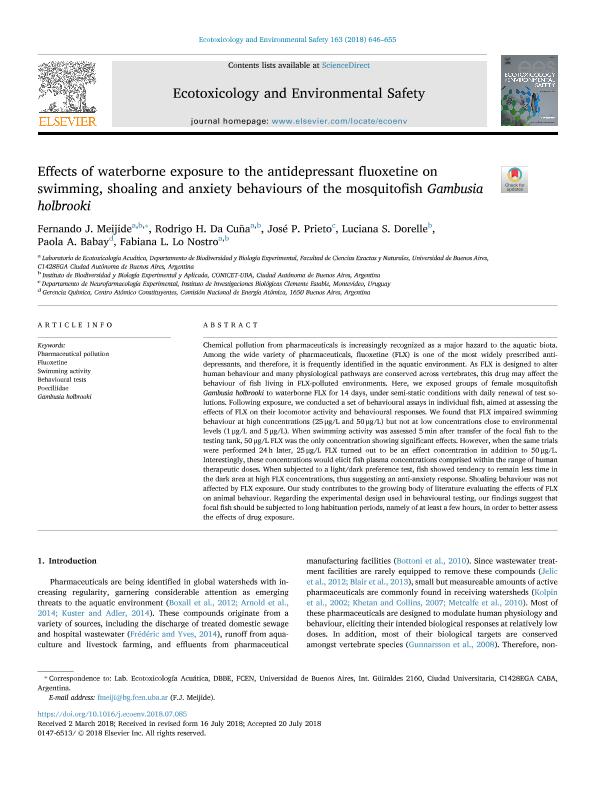Artículo
Effects of waterborne exposure to the antidepressant fluoxetine on swimming, shoaling and anxiety behaviours of the mosquitofish Gambusia holbrooki
Meijide, Fernando Javier ; Da Cuña, Rodrigo Hernán
; Da Cuña, Rodrigo Hernán ; Prieto, José P.; Dorelle, Luciana Soledad
; Prieto, José P.; Dorelle, Luciana Soledad ; Babay, Paola Alejandra; Lo Nostro, Fabiana Laura
; Babay, Paola Alejandra; Lo Nostro, Fabiana Laura
 ; Da Cuña, Rodrigo Hernán
; Da Cuña, Rodrigo Hernán ; Prieto, José P.; Dorelle, Luciana Soledad
; Prieto, José P.; Dorelle, Luciana Soledad ; Babay, Paola Alejandra; Lo Nostro, Fabiana Laura
; Babay, Paola Alejandra; Lo Nostro, Fabiana Laura
Fecha de publicación:
11/2018
Editorial:
Academic Press Inc Elsevier Science
Revista:
Ecotoxicology and Environmental Safety
ISSN:
0147-6513
Idioma:
Inglés
Tipo de recurso:
Artículo publicado
Clasificación temática:
Resumen
Chemical pollution from pharmaceuticals is increasingly recognized as a major hazard to the aquatic biota. Among the wide variety of pharmaceuticals, fluoxetine (FLX) is one of the most widely prescribed antidepressants, and therefore, it is frequently identified in the aquatic environment. As FLX is designed to alter human behaviour and many physiological pathways are conserved across vertebrates, this drug may affect the behaviour of fish living in FLX-polluted environments. Here, we exposed groups of female mosquitofish Gambusia holbrooki to waterborne FLX for 14 days, under semi-static conditions with daily renewal of test solutions. Following exposure, we conducted a set of behavioural assays in individual fish, aimed at assessing the effects of FLX on their locomotor activity and behavioural responses. We found that FLX impaired swimming behaviour at high concentrations (25 μg/L and 50 μg/L) but not at low concentrations close to environmental levels (1 μg/L and 5 μg/L). When swimming activity was assessed 5 min after transfer of the focal fish to the testing tank, 50 μg/L FLX was the only concentration showing significant effects. However, when the same trials were performed 24 h later, 25 μg/L FLX turned out to be an effect concentration in addition to 50 μg/L. Interestingly, these concentrations would elicit fish plasma concentrations comprised within the range of human therapeutic doses. When subjected to a light/dark preference test, fish showed tendency to remain less time in the dark area at high FLX concentrations, thus suggesting an anti-anxiety response. Shoaling behaviour was not affected by FLX exposure. Our study contributes to the growing body of literature evaluating the effects of FLX on animal behaviour. Regarding the experimental design used in behavioural testing, our findings suggest that focal fish should be subjected to long habituation periods, namely of at least a few hours, in order to better assess the effects of drug exposure.
Archivos asociados
Licencia
Identificadores
Colecciones
Articulos(IBBEA)
Articulos de INSTITUTO DE BIODIVERSIDAD Y BIOLOGIA EXPERIMENTAL Y APLICADA
Articulos de INSTITUTO DE BIODIVERSIDAD Y BIOLOGIA EXPERIMENTAL Y APLICADA
Citación
Meijide, Fernando Javier; Da Cuña, Rodrigo Hernán; Prieto, José P.; Dorelle, Luciana Soledad; Babay, Paola Alejandra; et al.; Effects of waterborne exposure to the antidepressant fluoxetine on swimming, shoaling and anxiety behaviours of the mosquitofish Gambusia holbrooki; Academic Press Inc Elsevier Science; Ecotoxicology and Environmental Safety; 163; 11-2018; 646-655
Compartir
Altmétricas



